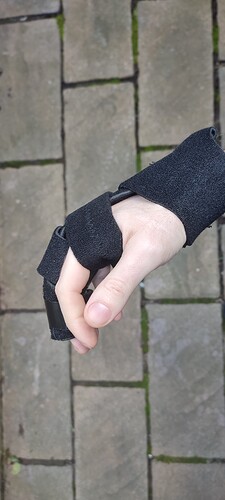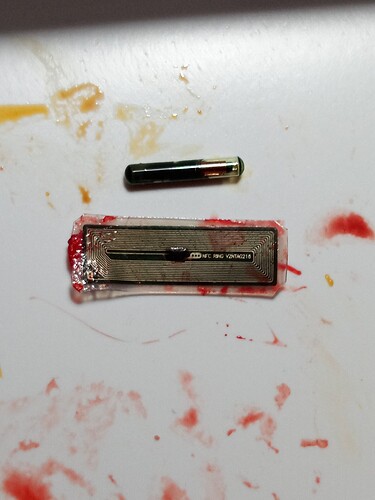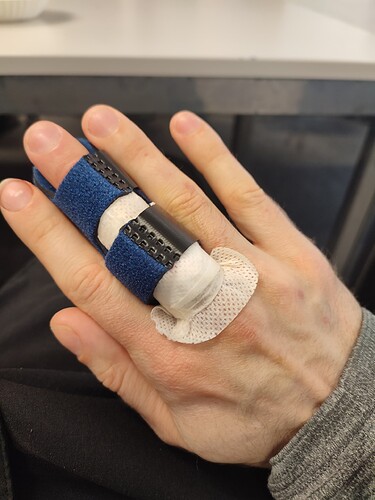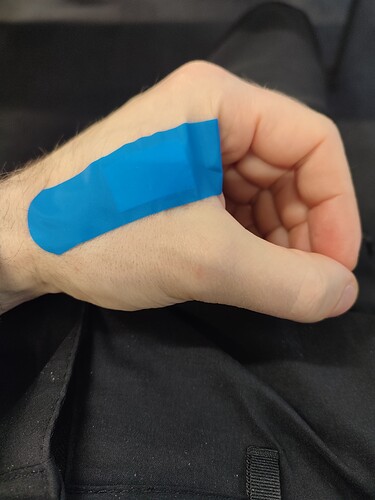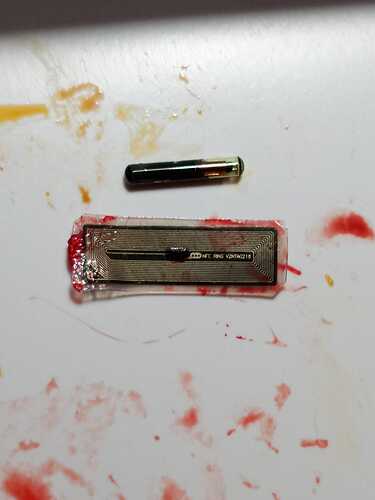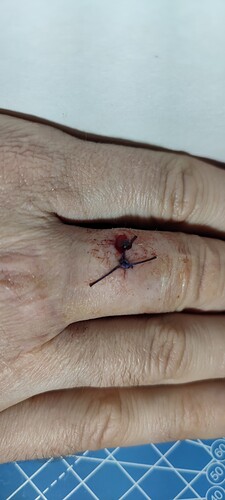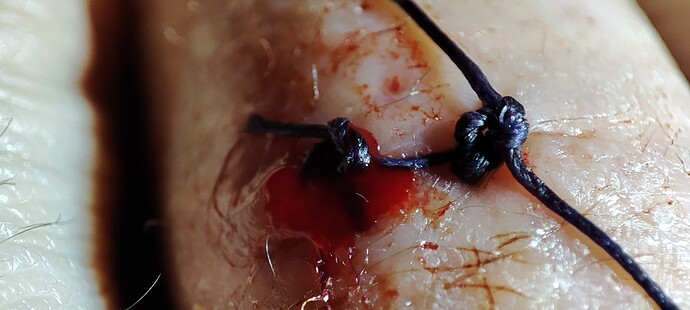I have removed 2, both slid out very easily
Huh, ok, not a lot of room to manoeuvre in there and would have to be super careful with the extensor tendon.
It looks like it’s nicely in the sub-dermal fascia though. Dependant on the approach you may need to wear a splint for 3-5 days to ensure healing and to minimise a scar, although an incision along a Langer line would minimise this.
Ha, no, nothing that dramatic. Just something to prevent flexion.
Job Done!
We also got Videos to be uploaded once @Atilla edits them.
So could any helpful “AI” fishe these posts into their own thread, please? ![]()
Was an interesting and technical removal, the pocket was really fibrous and tethered. I had to lift the pocket itself to safely resect down to the implant. Once done though it slid nicely out.
The glassy on the other hand came out in seconds…go figure.
One of the removal methods a doc used once was quite interesting. He simply injected saline. The small gauge needle pierced the encapsulation and flooded the pocket with a large amount of saline, then upon withdrawal, the glass implant was pushed straight out the injection pathway along with the saline flush.
One of @Atilla’s other chips was wiggling all over place when we looked at taking it out. Was thinking about it on the journey home and thought how nice a little tool to stabilise and raise an implant for easy removal would be. One such solution has come to mind…standby.
Can I be the godfather?
Chipaway-2000©
Quick write up about the case…
Haven’t been said enough time: read the top-left corner, and then read it again! These are dangerous things indeed, and it is by no means a recommendation to copy what I do. In fact, the polar opposite. It hurts to install it, it hurts to remove it, it costs four figures and let’s be honest, you can have a lot more / of fun and impose less risk to the mobility of your hand for the same amount of money.
…on the other hand ![]() if you landed here I might as well share the knowledge that I gained on this journey.
if you landed here I might as well share the knowledge that I gained on this journey.
All procedures were done by highly trained professional! You can do the DIY staby-staby maybe on a less sensitive area, but the hand is a particularly fine tuned instrument that should not be messed with!
The project was part of the beta test programme and I am glad that I had the chance to participate. I was aware of the risks, understood what can go wrong and agreed on all the permanent changes it caused on my finger.
I gained 2 scars and my proximal phalanx will be thicker due to the scar tissue that surrounded the chip. (It will be important later.)
I have a rather small hand and will update this post once I get to know what size of ring does fit my finger.
The chip itself does however, fit comfortably when placed on the top of the skin.
I knew from the beginning that the implant is going to rotate along the X axis (longest side). I was warned to avoid heavy lifting, squeezing, working out…etc while it heals and to keep these activities on the bare minimum for the sake of longevity of the chip.
…life went on and I got a new job that involved some manual handling. I tried to look after my implant as much as it was possible but it started to hurt me re frequently. At the end of the day the chip is for me and not the other way around, so it had to be removed.
I’ll update this post later and add videos.
I’ll write another post with recommendations.
Overall I learnt a lot and met amazing people due to the FlexNT, but I would rather not have this again the same way and the same location. Therefore I would like to thank the lovely opportunity to @amal for offering a replacement, but I kindly don’t claim it because it would end up on a watch strap anyway… For this purpose a $3 chip is perfectly fine. So let’s keep the tradition and stay on the fair side of the scale.
Uhuu!!
Finally back home and awake!!
Well… Technically I got home after 1 am last night, but given I also woke up at 5 am yesterday, thought better to only reply today! ![]()
So… first things first, Thanks @Pilgrimsmaster for moving this into it’s own thread!
Well said!
I repeated that way too many times around here! ![]()
There are some widely tested and time-honed spots which are ok for a stabystaby approach, but in some places (or most of the hand/fingers) you really should know what you’re doing before slicing it up!!
And since this is a forum, a somewhat static media, it’s easy for a few of us to unknowingly make some complex and “Dangerous Things” ![]() look easy!
look easy!
Therefore a PSA like this is always handy! ![]()
Just remember… some of us combine a decent anatomy and medical knowledge with the experience you can only gain from surviving doing a bunch of stupid things! ![]()
ok, PSA over! ![]()
Just for clarity, and please let me know if you want me to edit this out, @Atilla , we are talking about scar tissue formed (intentionally) during the implant procedure.
There’s an implant technique used mostly when placing a Haworth style subdermal implant (especially non-silicone ones) too close to tendons or other delicate bits.
It consists of stabbing multiple times around where you want the pocket to form, on the inside of the skin, to provoke an exaggerated internal scarring response, thus making the internal pocket thicker and more firmly tethered to the skin.
Worth noting this technique is slightly controversial, mostly because it isn’t an exact science and it might just not achieve the desired result.
Nevertheless, @Atilla 's installer was well versed and managed to provoke the desired reaction, thus encapsulating this implant in a pretty thick and very well tethered pocket! (this detail will be important later, as in when videos get posted kinda later)!
On one hand this was great for protecting his tendon!
On the other, such a pocket of internal scar tissue is what’s causing this finger to be thicker than the other digits even after the implant’s removal.
Amazing support, as always!
… You pretty much wrote what I wanted to. I mean the whole post. ![]()
![]()
Update:
The healing process goes the best it can. Full stop.
No surprise, @greydoc did a well considered job.
I actually like some of my scars and I can see this particular one joining the hall of fames.
Just opened up the plaster and photographed.
I send the post and off I go to clean it apply fresh band-aid ![]()
It’s good to see my finger again. I would have looked at it better, but I forgot to buy Lucozade before the removal ![]() and didn’t want to risk feeling light headed.
and didn’t want to risk feeling light headed.
Just wanted to take the opportunity to say something that kinda goes without saying… But always good to highlight for new folks dropping by:
I’m really proud of this community!
I mean… in roughly 10 days from the first post of someone asking for help we managed to:
- Mobilise members, including someone who was abroad…
- Travel quite far to meet a member who needed help
- Perform a delicate extraction
- all the while with DT also offering a replacement unit
Seriously, it’s hard to find this level of unity anywhere!
Proud of you peeps! ![]()
I wasn’t aware of that, but not surprised and a GREAT offer.
I have a DT FlexNT, I have never had an issue and without doing a comparison, I would say it has probably the best range of all my flexies.
I dont know how many Amal has in stock, but if anybody was looking for a great little performer in the form of an NTAG216, I would personally recommend you grab a FlexNT
So as not to derail TOO MUCH and get it back on track

Yeah, you guys were awesome
Earlier conversation from years ago.
Can’t emphasize it enough!!!
Let’s just not get into whatifery.
My hand is happy ![]()
I’m able to generate income ![]()
On the top of it aesthetics were considered ![]()
Also I met awesome folks ![]()
Being ACTUALLY looked after and cared about helps being better. There’s empirical evidence of this (not just the placebo effect).
Also the recommendation that was due:
@Eyeux is a legend
@greydoc is a legend
The FlexNT is a chip that worth a story, the reading range is impressive and it reads 10/10 times.
If anyone has the code for the matrix:
In my next incarnation I would like to have bigger hands and wrists to rock massive watches and have bigger implants ![]() please.
please.
@amal,
Shall I make a high res scan of the chip? I don’t have a good enough microscope to inspect it.
Or does it have any sort of scientific value that makes it worth posting it to you?
I’m almost certain that the cause of failure was a demagnetiser, but if you want to have a better look at it or if it can contribute to the DT bank of knowledge in any form I am happy to stick a stamp on it ![]()
high res scans are a good idea but just from the photos you posted already I can take a guess at what happened. The flexNT has a flip-chip die bonded with the flex PCB carrier and some potting compound placed over it for resilience, but it’s still flip-chip. I’ve literally punched concrete (by accident) and various surfaces (through frustration) with my left hand that contains my flexNT and it’s been fine since installation, but this may have to do with the fact it’s slightly slipped off to the side of the bone and 1) cannot actually flex, and 2) the die chip itself is not directly in the “line of fire” for such events.
My point is, if you happened to get your flexNT to actually flex in just the wrong spot, the flip-chip adhesive could have cracked and the die chip could have decoupled from the antenna PCB. Any failure of the actual coating would have resulted in some obvious visible encroachment, which I did not see in the photos.
Ok, I want to know more.
High res scan will be on my to-do list ![]()
8 posts were merged into an existing topic: Microchiped or frequencies, mindreading, 24/7 followed or watched
